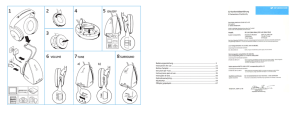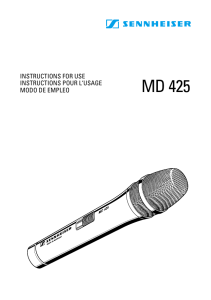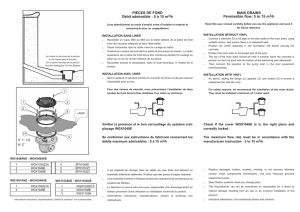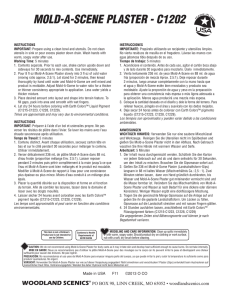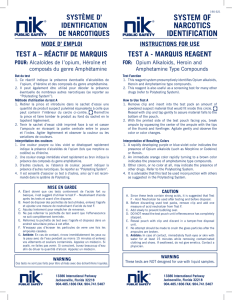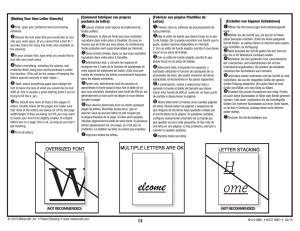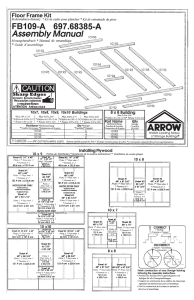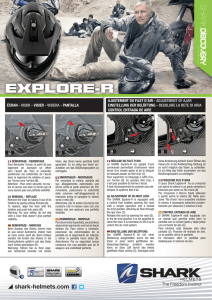ON/OFF 6VOLUME/BALANCE 7 TUNE a) b) COMPRESSION
Anuncio
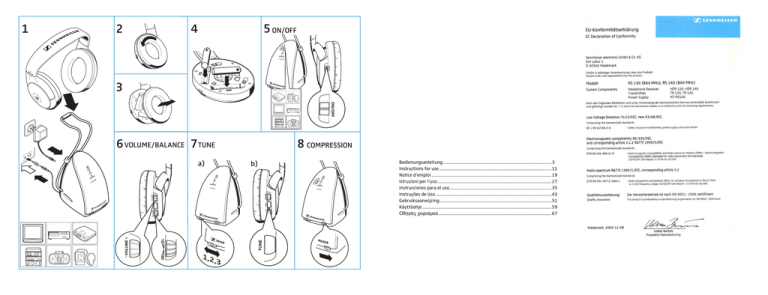
2 5 ON/OFF 4 3 6 VOLUME/BALANCE 7 TUNE b) L a) 8 COMPRESSION R L R L 1 Bedienungsanleitung..................................................................................................3 Instructions for use .....................................................................................................11 Notice d’emploi ............................................................................................................19 Istruzioni per l’uso.......................................................................................................27 Instrucciones para el uso............................................................................................35 Instruções de Uso ........................................................................................................43 Gebruiksaanwijzing.....................................................................................................51 Käyttöohje ....................................................................................................................59 Οδηγίες χειρισµού......................................................................................................67 Bedienungsanleitung Instruction Manual Notice d´emploi Istruzioni per l´uso Instrucciones para el uso Instruções de Uso Gebruiksaanwijzing Käyttöohje Οδηγίες χειρισµού Konformitätserklärung Sennheiser electronic GmbH & Co. KG erklären, dass dieses Gerät die anwendbaren CE-Normen und Vorschriften erfüllt. RS 140 Approval Sennheiser electronic GmbH & Co. KG declare that this device is in compliance with the applicable CE standards and regulations. Certification Sennheiser electronic GmbH & Co. KG déclarons que cet appareil est en conformité avec les normes CE. Certificazione Sennheiser electronic GmbH & Co. KG diachiara che questo apparecchio risponde alle normative e alle prescrizioni CE applicabili. Autorizacion Sennheiser electronic GmbH & Co. KG declara que este aparato cumple las normas y directrices de la CE aplicables. Declaração de conformidade A Sennheiser electronic GmbH & Co. KG declara que este aparelho cumpre as normas CE e prescrições aplicáveis. Vergunning Sennheiser electronic GmbH & Co. KG verklaren, dat dit toestel voldoet aan de toepasselijke CE-normen en voorschriften. L Vaatimustenmukaisuustodistus Sennheiser electronic GmbH & Co. KG vahvistaa, että tämä laite on tarvittavien CE-normien ja määräysten mukainen. Sennheiser electronic GmbH & Co. KG 30900 Wedemark, Germany Phone +49 (5130) 600 0 Fax +49 (5130) 600 300 www.sennheiser.com Printed in China Publ. 05/05 511734/A02 ∆ήλωση Συµµόρφωσης Η εταιρία Sennheiser electronic GmbH & Co. KG δηλώνει ότι η παρούσα συσκευή ανταποκρίνεται στα εφαρµοσθέντα πρότυπα CE και στις εφαρµοσθείσες προδιαγραφές. FCC Rules This equipment has been tested and found to comply with the limits for a Class B digital device, pursuant to Part 15 of the FCC Rules. These limits are designed to provide reasonable protection against harmful interference in a residential installation. This equipment generates, uses and can radiate radio frequency energy and, if not installed and used in accordance with the instructions, may cause harmful interference to radio communications. However, there is no guarantee that interference will not occur in a particular installation. If this equipment does cause harmful interference to radio or television reception, which can be determined by turning the equipment off and on, the user is encouraged to try to correct the interference by one or more of the following measures: 1) Reorient or relocate the receiving antenna. 2) Increase the separation between the equipment and receiver. 3) Connect the equipment into an outlet on a circuit different from that to which the receiver is connected. 4) Consult the dealer or an experienced radio/TV technician for help. The users manual or instruction manual for an intentional or unintentional radiator shall caution the user that changes or modifications not expressly approved by the party responsible for compliance could void the user's authority to operate the equipment. Warning: Changes or modifications made to this equipment not expressly approved by Sennheiser electronic Corp. may void the FCC authorization to operate this equipment. RS140_d.fm Seite 3 Dienstag, 25. Oktober 2005 5:37 17 Dieses Funkkopfhörersystem der gehobenen Klasse eignet sich hervorragend für den Einsatz an HiFi- und Fernsehgeräten. Es bietet höchsten Tragekomfort und technische Innovationen wie: y Automatisches Ein- und Ausschalten des Senders y Automatische Sendersuche mit Memory-Funktion y Selbstlernende Aussteuerungs-Automatik mit Memory-Funktion y Hervorragende Sprachverständlichkeit durch eine dynamische Kompression y Automatische Rauschreduzierung, z.B. in Sendepausen y Automatische Funktions-Rückmeldung y Hohe Lautstärken einstellbar y Balance-Regler für L-/R-Anpassung y Intelligente Akku-Ladetechnik Lieferumfang y Kopfhörer: HDR 140 y Akku: 2 x Typ AAA Ni-MH 1,2 V y Sender: TR 140 mit Audio-Anschlusskabel (fest angeschlossen) y Steckernetzteil: NT-RS 100 y Adapter 6,3-mm-Klinke y Cinch-Adapter (nur 926-MHz-Version) y Bedienungsanleitung 3 Deutsch RS 140 RS140_d.fm Seite 4 Dienstag, 25. Oktober 2005 5:37 17 Deutsch Sicherheitsinformationen Öffnen Sie weder Sender noch Hörer, da sonst Verletzungsgefahr besteht und die Garantie erlischt. Achtung: Benutzen Sie den Kopfhörer nicht, wenn Ihre Umgebung besondere Aufmerksamkeit erfordert (z.B. im Straßenverkehr, bei handwerklichen Tätigkeiten). Achtung: Lautes Hören kann Hörschäden verursachen! Achtung: Keine Batterien über den Kopfhörer laden! Nur aufladbare Akkus verwenden (Explosionsgefahr)! Alte Akkus nur leer über den Fachhandel oder Batteriecontainer entsorgen. y Halten Sie das Gerät stets trocken und setzen Sie es weder extrem niedrigen noch extrem hohen Temperaturen aus (ideal: 10 bis 35°C). y Behandeln Sie das Gerät sorgfältig und stellen Sie es an einem sauberen, staubfreien Ort auf. y Lacke und Möbelpolituren können die Füße des Senders angreifen und so Flecken auf Ihren Möbeln verursachen. y Bewahren Sie den Kopfhörer nicht über längere Zeit mit gespreiztem Bügel auf, da die Bügelspannung nachlassen kann. y Verwenden Sie zur Reinigung der Geräte ein weiches Tuch. Vermeiden Sie scharfe Reinigungsmittel. Wandmontage Der Sender ist für die Wandmontage vorbereitet. Die dazu benötigten handelsüblichen Schrauben und Dübel sind nicht im Lieferumfang enthalten. 4 RS140_d.fm Seite 5 Dienstag, 25. Oktober 2005 5:37 17 Stellen Sie die Steckverbindungen her (Steckernetzteil, Audioanschluss). Ohrpolster abnehmen (Abb. 2 u. 3) Die Ohrpolster sind mit einem Bajonettverschluss an der Ohrmuschel befestigt. Um die Polster zu lösen, drehen Sie sie in Pfeilrichtung über einen leichten Widerstand und heben Sie sie von der Ohrmuschel ab. Akkus einsetzen (Abb. 4) Nehmen Sie das linke Ohrpolster ab (Abb. 2 & 3). Setzen Sie die Akkus ein. Achtung: Achten Sie dabei auf die richtige Polarität! Akkus laden Zum Laden hängen Sie den Kopfhörer auf den Bügel des Senders. (Der Hörer schaltet sich beim Laden automatisch aus.) Die rote LED CHARGE leuchtet während des Ladevorganges. Sind die Akkus vollständig geladen, so schaltet das Gerät auf Erhaltungsladung um und die LED CHARGE blinkt langsam. Nach dem Einlegen der Akkus werden diese zunächst für ca. 16 Stunden vollständig geladen. Anschließend entspricht die Zeit für das Aufladen ungefähr der vorherigen Benutzungsdauer. Grundsätzlich erreichen Sie den besten Ladezustand, indem Sie den Hörer immer auf dem Sender aufbewahren. Die Ladeautomatik verhindert eine Überladung der Akkus. Wird der Kopfhörer längere Zeit nicht benutzt, nehmen Sie bitte die Akkus aus dem Hörer und trennen das Steckernetzteil vom Stromnetz. Nahezu entladene Akkus führen zu deutlichen Klangeinbußen. Ca. 10 Minuten bevor die Akkus vollständig entladen sind und der Hörer sich abschaltet, ertönt ein Warnsignal (2 mal lang, vgl. Tabelle S. 8). Sender ein- und ausschalten (Abb. 5) Schalten Sie die Tonquelle ein. Der Sender wird dadurch automatisch aktiviert und die grüne LED ON/OFF leuchtet. Wird die Tonquelle aus5 Deutsch Sender anschließen (Abb. 1) Deutsch RS140_d.fm Seite 6 Dienstag, 25. Oktober 2005 5:37 17 geschaltet, schaltet sich der Sender nach ca. 3 Minuten automatisch ab (LED ON/OFF erlischt). Hinweis: Für die automatische Aussteuerung muss die Lautstärke der Tonquelle ausreichend hoch eingestellt sein. Hörer ein- und ausschalten (ON/OFF, Abb. 5) Schieben Sie den Schalter ON/OFF am Kopfhörer in die Position ON. Anschließend beginnt der Hörer mit dem automatischen Sendersuchlauf. Lautstärke einstellen (VOLUME, Abb. 6) Stellen Sie mit dem Regler VOLUME die Lautstärke des Kopfhörers ein. Balance einstellen (BALANCE, Abb. 6) Stellen Sie das Lautstärkeverhältnis zwischen linker und rechter Seite über den Regler BALANCE ein. In der Mittelstellung rastet der Regler fühlbar ein. Autotuning - Automatische Sendersuche mit MemoryFunktion (TUNE, Abb. 7) Hinweis: Der Sender muss aktiv sein (grüne LED ON/OFF leuchtet) und der Kopfhörer muss eingeschaltet sein. Durch Drücken der Taste TUNE bzw. nach dem Einschalten beginnt der Hörer den gesamten zur Verfügung stehenden Frequenzbereich nach einem Sendersignal zu durchsuchen. Wird ein solches Signal gefunden, stoppt der Suchlauf und die Übertragung des Tonsignals beginnt. Sollte das gefundene Signal nicht das gewünschte sein (z.B. das eines Nachbarn), kann durch nochmaliges Drücken der Taste TUNE der Suchlauf fortgesetzt werden. Nach dem Einschalten des Hörers beginnt die Suche grundsätzlich auf dem zuletzt gehörten Kanal. Sollte das Sendersignal längere Zeit ausbleiben, z.B. durch Überschreiten der Reichweite oder Deaktivieren des Senders, so ertönen 6 kurze Warntöne. Fehlt das Sendersignal für mehr als 10 Minuten, 6 schaltet sich der Hörer automatisch ab. Er kann dann durch Drücken der Taste TUNE wieder eingeschaltet werden. Selbstlernende Aussteuerungs-Automatik mit Memory-Funktion Der Sender ist mit einer automatischen Aussteuerung ausgestattet, um zu gewährleisten, dass der Kopfhörer stets ein optimales Signal empfängt. Die Aussteuerung wird während des Betriebes ständig angepasst und bleibt gespeichert, solange der Sender mit Strom versorgt wird. Untersteuerung (Tonsignal zu schwach) Bei Untersteuerung blinkt die gelbe LED INPUT LEVEL im Sekundentakt. Erhöhen Sie in diesem Fall die Lautstärke der Tonquelle bitte langsam. Bleibt das Tonsignal zu schwach, ist keine optimale Übertragung erreicht. Evtl. schaltet der Sender nach einiger Zeit ab. Übersteuerung (Tonsignal zu stark) Bei Übersteuerung blinkt die gelbe LED INPUT LEVEL schnell. Verringern Sie in diesem Fall die Lautstärke der Tonquelle langsam. Dynamische Kompression (COMPRESSION, Abb. 8) Dieses Gerät ist mit einer zuschaltbaren dynamischen Kompression ausgestattet. Leisere Passagen des Tonsignals werden dabei angehoben, lautere abgesenkt. Sie aktivieren Sie diese Funktion, indem Sie den Schalter COMPRESSION am Sender in die rechte Position schieben. Die gelbe LED COMPRESSION leuchtet dann. Sollte die LED langsam blinken, erhöhen Sie langsam die Lautstärke der Tonquelle (vgl. „Untersteuerung“). Automatische Rauschreduktion Zusätzlich verfügt der Sender über eine so genannte Noise-GateFunktion, die das sonst übliche Aufrauschen automatisch reduziert, wenn kein Ton gesendet wird (z.B. bei Pausen). 7 Deutsch RS140_d.fm Seite 7 Dienstag, 25. Oktober 2005 5:37 17 RS140_d.fm Seite 8 Dienstag, 25. Oktober 2005 5:37 17 Deutsch Bedeutung der Anzeigen und Quittungstöne Sender, LED Erläuterung ON/OFF (grün) leuchtet Tonsignal liegt an, Sender ist aktiv CHARGE (rot) leuchtet Akkus werden geladen blinkt langsam Akkus sind geladen, Erhaltungsladung aktiv leuchtet „COMPRESSION“Funktion aktiv blinkt langsam Tonquelle zu leise blinkt schnell Tonquelle zu laut COMPRESSION INPUT LEVEL (gelb) Kopfhörer, Quittungstöne 8 Zustand Erläuterung Bemerkung 6 x kurz Sendersignal fehlt (Sender nicht aktiv oder Reichweite überschritten) Automatisches Abschalten nach ca. 10 Min. 2 x lang Akkukapazität fast erschöpft Automatisches Abschalten nach ca. 10 Min. Tonfolge (3 Töne) manuelles oder automatisches Abschalten — RS140_d.fm Seite 9 Dienstag, 25. Oktober 2005 5:37 17 Die Quittungstöne des Hörers lassen sich folgendermaßen aus- oder wieder einschalten: y Hörer einschalten y 5 Sekunden lang Taster TUNE drücken y Hörer ausschalten y Wenn die Quittungstöne eingeschaltet sind, erklingt beim Ausschalten des Hörers eine Tonfolge. Wenn Sie keine Tonfolge hören, sind die Quittungstöne nun ausgeschaltet. Was tun, wenn etwas nicht funktioniert... y Kontrollieren Sie, ob alle Stecker richtig eingesteckt sind. y Stellen Sie sicher, dass die Akkus mindestens 20 Minuten geladen worden sind. y Kontrollieren Sie den Sitz und die Polung der Akkus im Kopfhörer. y Prüfen Sie, ob Hörer und Tonquelle eingeschaltet und laut genug sind. y Gehen Sie mit dem Hörer näher an den Sender heran. y Wählen Sie einen anderen Kanal am Sender. y Drücken Sie die Taste TUNE erneut. y Zurücksetzen in den Auslieferungszustand (Resetfunktion): Nehmen Sie die Akkus aus dem Kopfhörer und unterbrechen Sie gleichzeitig die Stromversorgung des Senders für mindestens 30 Sekunden. y Einige elektronische Geräte (z.B. Fernseher) können Störungen verursachen. Diese lassen sich durch einen größeren Abstand zwischen Sender und Störquelle beseitigen. y Versuchen Sie, den Sender an einer anderen Tonsignalquelle in Betrieb zu nehmen. Sollte sich der Fehler nicht beheben lassen, wenden Sie sich bitte an Ihren Fachhändler. 9 Deutsch Quittungstöne ein- und ausschalten RS140_d.fm Seite 10 Dienstag, 25. Oktober 2005 5:37 17 Deutsch Zubehör y Zweithörer: y Ersatzohrpolster: HDR 140 (864-MHz) Art. Nr. 009934 HDR 140 (926-MHz) Art. Nr. 009935 Art. Nr. 511792 Verwenden Sie nur Original-Sennheiser-Komponenten und -Ersatzteile. Andernfalls können Schäden am Gerät auftreten und die Garantie erlischt. Garantie 2 Jahre Garantie Zulassungsvorschriften Beachten Sie die länderspezifischen Zulassungsvorschriften! Technische Daten Modulationsverfahren Frequenzbereich NF-Übertragungsbereich Rauschspannungsabstand Sender TR 140 HF-Strahlungsleistung Stromversorgung Stromaufnahme Kanäle Stecker Gewicht Abmessungen Hörer HDR 140 Wandlerprinzip Max. Schalldruck bei 1 kHz Klirrfaktor Stromversorgung Ladezeit Betriebszeit Gewicht 10 FM stereo siehe Typenschild unter dem Sender 18 Hz – 21 kHz typ. >68 dBA <10 mW (864-MHz-Version) <0,75 mW (926-MHz-Version) 9 V DC über NT-RS 100 Netzteil <1,8 VA 3 3,5-mm-Klinke (864-MHz-Version) Cinch-Adapter (926-MHz-Version) ca. 430 g (inkl. Audiokabel) Breite 85 mm, Tiefe 133 mm, Höhe 225 mm (inkl. Bügel) dynamisch, ohrumschließend, geschlossen 110 dB <0,5% 2 AAA Ni-MH Akkus (LR 03) ca. 16 h (Volladung) ca. 23 h (bei vollständig geladenen Akkus) ca. 280 g inkl. Akkus 2 5 ON/OFF 4 3 6 VOLUME/BALANCE 7 TUNE b) L a) 8 COMPRESSION R L R L 1 Bedienungsanleitung..................................................................................................3 Instructions for use .....................................................................................................11 Notice d’emploi ............................................................................................................19 Istruzioni per l’uso.......................................................................................................27 Instrucciones para el uso............................................................................................35 Instruções de Uso ........................................................................................................43 Gebruiksaanwijzing.....................................................................................................51 Käyttöohje ....................................................................................................................59 Οδηγίες χειρισµού......................................................................................................67 Bedienungsanleitung Instruction Manual Notice d´emploi Istruzioni per l´uso Instrucciones para el uso Instruções de Uso Gebruiksaanwijzing Käyttöohje Οδηγίες χειρισµού Konformitätserklärung Sennheiser electronic GmbH & Co. KG erklären, dass dieses Gerät die anwendbaren CE-Normen und Vorschriften erfüllt. RS 140 Approval Sennheiser electronic GmbH & Co. KG declare that this device is in compliance with the applicable CE standards and regulations. Certification Sennheiser electronic GmbH & Co. KG déclarons que cet appareil est en conformité avec les normes CE. Certificazione Sennheiser electronic GmbH & Co. KG diachiara che questo apparecchio risponde alle normative e alle prescrizioni CE applicabili. Autorizacion Sennheiser electronic GmbH & Co. KG declara que este aparato cumple las normas y directrices de la CE aplicables. Declaração de conformidade A Sennheiser electronic GmbH & Co. KG declara que este aparelho cumpre as normas CE e prescrições aplicáveis. Vergunning Sennheiser electronic GmbH & Co. KG verklaren, dat dit toestel voldoet aan de toepasselijke CE-normen en voorschriften. L Vaatimustenmukaisuustodistus Sennheiser electronic GmbH & Co. KG vahvistaa, että tämä laite on tarvittavien CE-normien ja määräysten mukainen. Sennheiser electronic GmbH & Co. KG 30900 Wedemark, Germany Phone +49 (5130) 600 0 Fax +49 (5130) 600 300 www.sennheiser.com Printed in China Publ. 05/05 511734/A02 ∆ήλωση Συµµόρφωσης Η εταιρία Sennheiser electronic GmbH & Co. KG δηλώνει ότι η παρούσα συσκευή ανταποκρίνεται στα εφαρµοσθέντα πρότυπα CE και στις εφαρµοσθείσες προδιαγραφές. FCC Rules This equipment has been tested and found to comply with the limits for a Class B digital device, pursuant to Part 15 of the FCC Rules. These limits are designed to provide reasonable protection against harmful interference in a residential installation. This equipment generates, uses and can radiate radio frequency energy and, if not installed and used in accordance with the instructions, may cause harmful interference to radio communications. However, there is no guarantee that interference will not occur in a particular installation. If this equipment does cause harmful interference to radio or television reception, which can be determined by turning the equipment off and on, the user is encouraged to try to correct the interference by one or more of the following measures: 1) Reorient or relocate the receiving antenna. 2) Increase the separation between the equipment and receiver. 3) Connect the equipment into an outlet on a circuit different from that to which the receiver is connected. 4) Consult the dealer or an experienced radio/TV technician for help. The users manual or instruction manual for an intentional or unintentional radiator shall caution the user that changes or modifications not expressly approved by the party responsible for compliance could void the user's authority to operate the equipment. Warning: Changes or modifications made to this equipment not expressly approved by Sennheiser electronic Corp. may void the FCC authorization to operate this equipment. RS140_GB.fm Seite 11 Dienstag, 25. Oktober 2005 5:38 17 The RS 140 is an up-market wireless RF headphone system suitable for use with hi-fi systems and televisions. The headphones are very comfortable to wear and the system incorporates a variety of technical innovations such as: y Transmitter with automatic on/off function y Automatic transmitter search-tuning with memory function y Self-learning automatic level control with memory function y Switchable dynamic compression ensures excellent speech intelligibility y “Noise Gate” function reduces hissing noise, e.g. during pauses y Acoustic signals provide feedback on the functions y High output level (adjustable) y Balance control for right/left volume adjustment y Intelligent battery charging technology Delivery includes y HDR 140 headphones y 2 x AAA size Ni-MH rechargeable battery, 1.2 V y TR 140 transmitter with audio connecting cable (permanently connected) y NT-RS 100 mains unit y Adapter 3.5 mm/6.3 mm y RCA phono plug (926 MHz variant only) y Instructions for use 11 ENGLISH RS 140 RS140_GB.fm Seite 12 Dienstag, 25. Oktober 2005 5:38 17 Safety instructions Never open the transmitter nor the receiver, otherwise you can be injured and the warranty becomes null and void. ENGLISH Attention: Do not wear the headphones in situations which require special attention (e.g. in traffic or when performing skilled jobs). Attention: Listening at high volume levels can lead to hearing defects. Attention: Do not charge standard batteries via the headphones! Only use rechargeable batteries (danger of explosion)! Dispose of exhausted rechargeable batteries at special collection points or return them to your specialist dealer. y Always keep the system dry and do not expose it to extreme temperatures (ideally 10–35°C). y Use the system with care and set it up in a clean, dust-free environment. y Varnish or furniture polish may degrade the rubber feet of the transmitter, which could stain your furniture. y Do not store your headphones on a glass dummy head, chair armrest, or similar for long periods of time as this can widen the headband and reduce the contact pressure of the headphones. y Use a soft cloth for cleaning the units. Do not use abrasive cleaners. Wall mounting The transmitter is prepared for wall mounting. The required mounting hardware (screws and plugs) is not included in the delivery. 12 RS140_GB.fm Seite 13 Dienstag, 25. Oktober 2005 5:38 17 Connecting the transmitter (Fig. 1) Removing the ear cushions (Fig. 2 and 3) The ear cushions are secured to the earcups by means of a quarter turn fastener. To remove an ear cushion, turn it in the direction of the arrow until you overcome a slight resistance and lift it off the earcup. Inserting the rechargeable batteries (Fig. 4) Remove the left ear cushion (Fig. 2 and 3). Insert the rechargeable batteries. Attention: Observe correct polarity when inserting the batteries! Charging the rechargeable batteries For charging the batteries, place the headphones on the charging cradle of the transmitter. (The headphones automatically turn off during charging.) The red LED “CHARGE” lights up during the charging process. If the batteries are fully charged, the transmitter automatically switches to trickle charging and the red LED “CHARGE” flashes slowly. Charge the batteries for at least 16 hours prior to first time use. Subsequent charging time is about the same time as the previous operating time. Always store the headphones on the transmitter to ensure that they are fully charged when they are needed. The intelligent battery charging technology prevents overcharging. If you do not use the head-phones for extended periods of time, please remove the batteries and disconnect the transmitter’s mains unit from the mains. Nearly discharged batteries will significantly reduce the sound quality. Approx. 10 minutes before the batteries are completely discharged, an acoustic warning signal is produced (two long beeps, see table on page 16). 13 ENGLISH Establish the necessary connections (mains unit, audio connecting cable). RS140_GB.fm Seite 14 Dienstag, 25. Oktober 2005 5:38 17 Turning the transmitter on and off (Fig. 5) ENGLISH Turn on the sound source. This automatically activates the transmitter and the green LED “ON/OFF” lights up. If the sound source is turned off, the transmitter is automatically deactivated after approx. 3 minutes (the LED “ON/OFF” goes off). Note: The automatic level control only functions if the volume of the sound source is sufficient. Turning the headphones on and off (ON/OFF, Fig. 5) Move the “ON/OFF” switch on the headphones to the position “ON”. The headphones then start the transmitter search-tuning. Adjusting the volume (VOLUME, Fig. 6) Use the “VOLUME” control to adjust the volume on the headphones. Adjusting the balance (BALANCE, Fig. 6) Use the “BALANCE” control to adjust the volume of the right and left channels. There is a click-stop in the center position. Auto-tuning – automatic transmitter search-tuning with memory function (TUNE, Abb. 7) Note: The transmitter must be activated (green LED “ON/OFF” lit) and the headphones must be turned on. By pressing the TUNE button or after turn-on, the headphones start scanning the whole frequency range for a transmitter signal. If a transmitter signal is found, the transmitter search-tuning stops and the audio transmission starts. If, for some reason, the signal found is not the correct one (e.g. from another nearby system), press the TUNE button again and the transmitter search-tuning is continued. When turning on the headphones, they automatically start the transmitter search-tuning on the last selected channel. If no transmitter signal is received for an extended period of time (e.g. the range is exceeded or the transmitter is deactivated), six short beeps are produced. After approx. 10 minutes, the 14 RS140_GB.fm Seite 15 Dienstag, 25. Oktober 2005 5:38 17 headphones automatically turn off. By pressing the TUNE button, the headphones can be turned on again. The transmitter is equipped with an automatic level control which ensures that the headphones always receive an optimum signal. The level is continuously adjusted during operation and remains stored as long as the transmitter is connected to the mains. Under-modulation (audio signal too low) With under-modulation, the yellow LED “INPUT LEVEL” flashes slowly. If this happens, gradually increase the volume of the sound source. If the audio signal remains too weak, an optimum transmission is not possible. It could be that the transmitter is deactivated after some time. Over-modulation (audio signal too high) With over-modulation, the yellow LED “INPUT LEVEL” flashes rapidly. If this happens, gradually reduce the volume of the sound source. Dynamic compression system (Fig. 8) The RS 140 system is equipped with a switchable dynamic compression system. This system reproduces soft passages louder and decreases loud sounds. To activate the dynamic compression system, move the slide switch “COMPRESSION” on the transmitter to the right. The yellow LED “COMPRESSION” lights up. If the LED flashes slowly, gradually increase the volume of the sound source (see “Under-modulation”). Automatic noise reduction In addition, the transmitter features a “Noise Gate” function, which reduces hissing noise when no audio signal is transmitted (e.g. during pauses). 15 ENGLISH Self-learning automatic level control with memory function RS140_GB.fm Seite 16 Dienstag, 25. Oktober 2005 5:38 17 Meanings of the LEDs and acoustic signals ENGLISH Transmitter, LED Status Meaning ON/OFF (green) lit Audio signal is present, transmitter is activated CHARGE (red) lit Rechargeable batteries are being charged flashes slowly Rechargeable batteries are fully charged, transmitter has switched to trickle charging lit “COMPRESSION” function is activated flashes slowly Audio signal too low flashes rapidly Audio signal too high Meaning Commentary COMPRESSION INPUT LEVEL (yellow) Headphones, acoustic signals 6 short beeps No audio signal (transmitter is not activated, out of range) Automatic turn-off after approx. 10 minutes 2 long beeps Rechargeable batteries are flat Automatic turn-off after approx. 10 minutes Sequence of 3 beeps Manual or automatic turn-off — 1, 2 or 3 beeps after pressing TUNE Headphones tuned to channel 1, 2 or 3 — 16 RS140_GB.fm Seite 17 Dienstag, 25. Oktober 2005 5:38 17 Turning the acoustic signals (beeps) on and off The acoustic signals of the headphones can be turned on or off as follows: y Press the TUNE button for 5 seconds. y Turn the headphones off. y If the acoustic signals are turned on, the headphones produce a sequence of beeps at turn-off. If no beeps are produced, the acoustic signals are now turned off. If problems occur... y Check if all jack plugs are connected correctly. y Make sure that the batteries are charged. y Check if the batteries are inserted correctly and that the polarity is correct. y Check if the headphones and sound source are turned on and that the volume of the headphnes and sound source is sufficient. y Move closer to the transmitter. y Choose a different channel on the transmitter. y Press the TUNE button again. y Reset the system: Remove the rechargeable batteries from the headphones and – at the same time – interrupt the power supply of the transmitter for at least 30 seconds. y Some electronic devices (e.g. televisions) can cause interference, which can be eliminated by increasing the distance between the transmitter and the interference source. y Try to operate the transmitter with a different sound source. Should the problem persist, please contact your authorized dealer for assistance. 17 ENGLISH y Turn the headphones on. RS140_GB.fm Seite 18 Dienstag, 25. Oktober 2005 5:38 17 Accessories y Additional headphones: HDR 140 (864 MHz) Cat. No. 009934 HDR 140 (926 MHz) Cat. No. 009935 ENGLISH y Replacement ear cushions: Cat. No. 511792 Only use original Sennheiser components and spare parts, otherwise the units can be damaged and the warranty becomes null and void. Warranty 2-year warranty Type approval regulations Please observe the repective country-specific type approval regulations! Specifications Modulation Frequency range AF frequency response Signal-to-noise ratio TR 140 transmitter RF output power Power supply Current consumption Channels Connector Weight Dimensions HDR 140 headphones Transducer principle Max. SPL at 1 kHz THD Power supply Charging time Operating time Weight 18 FM stereo see type plate on the bottom of transmitter 18 Hz–21 kHz typ. > 68 dBA < 10 mW (864 MHz variant) < 0.75 mW (926 MHz variant) 9 V DC via NT-RS 100 mains unit < 1.8 VA 3 3.5 mm jack plug (864 MHz variant) RCA plug (926 MHz variant) approx. 430 g (incl. audio connecting cable) width: 85 mm, depth: 133 mm, height: 225 mm (incl. charging cradle) dynamic, circum-aural, closed 110 dB < 0.5% 2 AAA size Ni-MH rechargeable batteries (LR 03) approx. 16 h (full charge) approx. 23 h (with fully charged batteries) approx. 280 g incl. batteries 2 5 ON/OFF 4 3 6 VOLUME/BALANCE 7 TUNE b) L a) 8 COMPRESSION R L R L 1 Bedienungsanleitung..................................................................................................3 Instructions for use .....................................................................................................11 Notice d’emploi ............................................................................................................19 Istruzioni per l’uso.......................................................................................................27 Instrucciones para el uso............................................................................................35 Instruções de Uso ........................................................................................................43 Gebruiksaanwijzing.....................................................................................................51 Käyttöohje ....................................................................................................................59 Οδηγίες χειρισµού......................................................................................................67 Bedienungsanleitung Instruction Manual Notice d´emploi Istruzioni per l´uso Instrucciones para el uso Instruções de Uso Gebruiksaanwijzing Käyttöohje Οδηγίες χειρισµού Konformitätserklärung Sennheiser electronic GmbH & Co. KG erklären, dass dieses Gerät die anwendbaren CE-Normen und Vorschriften erfüllt. RS 140 Approval Sennheiser electronic GmbH & Co. KG declare that this device is in compliance with the applicable CE standards and regulations. Certification Sennheiser electronic GmbH & Co. KG déclarons que cet appareil est en conformité avec les normes CE. Certificazione Sennheiser electronic GmbH & Co. KG diachiara che questo apparecchio risponde alle normative e alle prescrizioni CE applicabili. Autorizacion Sennheiser electronic GmbH & Co. KG declara que este aparato cumple las normas y directrices de la CE aplicables. Declaração de conformidade A Sennheiser electronic GmbH & Co. KG declara que este aparelho cumpre as normas CE e prescrições aplicáveis. Vergunning Sennheiser electronic GmbH & Co. KG verklaren, dat dit toestel voldoet aan de toepasselijke CE-normen en voorschriften. L Vaatimustenmukaisuustodistus Sennheiser electronic GmbH & Co. KG vahvistaa, että tämä laite on tarvittavien CE-normien ja määräysten mukainen. Sennheiser electronic GmbH & Co. KG 30900 Wedemark, Germany Phone +49 (5130) 600 0 Fax +49 (5130) 600 300 www.sennheiser.com Printed in China Publ. 05/05 511734/A02 ∆ήλωση Συµµόρφωσης Η εταιρία Sennheiser electronic GmbH & Co. KG δηλώνει ότι η παρούσα συσκευή ανταποκρίνεται στα εφαρµοσθέντα πρότυπα CE και στις εφαρµοσθείσες προδιαγραφές. FCC Rules This equipment has been tested and found to comply with the limits for a Class B digital device, pursuant to Part 15 of the FCC Rules. These limits are designed to provide reasonable protection against harmful interference in a residential installation. This equipment generates, uses and can radiate radio frequency energy and, if not installed and used in accordance with the instructions, may cause harmful interference to radio communications. However, there is no guarantee that interference will not occur in a particular installation. If this equipment does cause harmful interference to radio or television reception, which can be determined by turning the equipment off and on, the user is encouraged to try to correct the interference by one or more of the following measures: 1) Reorient or relocate the receiving antenna. 2) Increase the separation between the equipment and receiver. 3) Connect the equipment into an outlet on a circuit different from that to which the receiver is connected. 4) Consult the dealer or an experienced radio/TV technician for help. The users manual or instruction manual for an intentional or unintentional radiator shall caution the user that changes or modifications not expressly approved by the party responsible for compliance could void the user's authority to operate the equipment. Warning: Changes or modifications made to this equipment not expressly approved by Sennheiser electronic Corp. may void the FCC authorization to operate this equipment. RS140_FR.fm Seite 19 Dienstag, 25. Oktober 2005 5:40 17 RS 140 Le RS 140 est un système sans fil haute fréquence idéal pour les systèmes hi-fi et la télévision. Le casque est très confortable et le systéme incorpore un grand nombre d'innovations techniques comme : y Recherche d'émetteur et réglage d'accord automatique avec fonction mémoire y Contrôle de niveau automatique avec fonction mémoire y Compression dynamique commutable, pour une meilleure intelligibilité de la parole y Fonction “Noise Gate” de réduction de bruit en cas d'absence de signal audio y Signaux acoustiques donnent des informations sur les fonctions y Niveau de sortie élevé (réglable) y Réglage de balance, pour équilibrage du volume gauche/droite y Système de recharge des batteries intelligent Fourniture y Casque HDR 140 y 2 batteries Ni-MH rechargeables du type AAA, 1,2 V y Emetteur TR 140 avec câble de raccordement (fixe) y Bloc secteur NT-RS 100 y Adaptateur 3,5 mm/6,3 mm y Connecteur RCA (uniquement pour la version 926 MHz) y Notice d'emploi 19 FRANCAIS y Emetteur avec fonction “Marche/Arrêt” automatique RS140_FR.fm Seite 20 Dienstag, 25. Oktober 2005 5:40 17 Instructions de sécurité N'ouvrez jamais les appareils sous peine de vous blesser et de perdre tout droit à la garantie. Attention : N’utilisez jamais le casque dans des situations demandant une attention spéciale, par exemple en automobile ou lors de travaux à risque. FRANCAIS Attention : Écouter à des niveaux sonores élevés peut provoquer des dommages auditifs. Attention : N'essayez jamais de recharger des piles standard. Utilisez uniquement des batteries (danger d'explosion) ! Déposez les batteries usagées dans un point de collecte spécifique ou ramenez-les à votre revendeur. y Veillez à ce que le système soit toujours sec et ne l'exposez pas à des températures extrêmes (idéalement : 10 à 35 °C). y Prenez soin du système et posez-le à un endroit propre et exempt de poussière. y Les peintures et cires de meubles peuvent altérer les pieds de l'émetteur et être à l'origine de taches sur vos meubles. y Ne stockez pas votre casque sur une tête factice, l'accoudoir d'une chaise, ou autre support semblable, pendant les longues périodes. Le bandeau pourrait s'en trouvé élargi et la pression de contact du casque réduite. y Utilisez un tissu doux pour nettoyer les appareils. N'utilisez jamais de détergents agressifs. Montage sur mur L'émetteur est prévu pour être monté contre un mur. Les accessoires de montage (vis et chevilles) ne sont pas inclus. Raccorder l'émetteur (Fig. 1) Procédez aux raccordements nécessaires (bloc secteur, câble de raccordement). 20 RS140_FR.fm Seite 21 Dienstag, 25. Oktober 2005 5:40 17 Remplacer les coussinets d'oreillette (Fig. 2 et 3) Les coussinets d'oreillette sont fixés à l'oreillette au moyen d'une fermeture à baïonnette. Pour remplacer les coussinets, tournez-les dans le sens de la flèche, au-delà de la petite résistance perceptible et retirez-les de l'oreillette. Retirez le coussinet d'oreillette gauche (Fig. 2 et 3). Insérez les batteries. Attention: Respectez la polarité lorsque vous insérez les batteries ! Charger les batteries rechargeable Pour charger les batteries, placez le casque sur le berceau de charge de l'émetteur. (Le casque s'éteint automatiquement lors de la charge.) La LED rouge “CHARGE” s'allume pendant la charge. Une fois que les batteries sont parfaitement chargées, l'émetteur passe automatiquement en charge d'entretien et la LED rouge “CHARGE” clignote lentement. Chargez les batteries pendant au moins 16 heures avant de les utiliser pour la première fois. Par la suite, la durée de recharge nécessaire est à peu près identique à la durée d'utilisation. Toujours replacez le casque sur l'émetteur de façon qu’il soit chargé au maximum lorsque vous en aurez besoin. Le système de recharge intelligent prévient tout risque de surcharge des batteries. Si vous n'utilisez pas le système RS 140 pendant une longue période, enlevez les batteries du casque et déconnectez le bloc secteur de l'émetteur du réseau électrique. Utiliser des batteries presque déchargées nuit à la qualité sonore. Env. 10 minutes avant la décharge complète, un signal d'alerte sonore retentit dans le casque (2 x longs, voir le tableau à la page 24). Allumer/éteindre l'émetteur (Fig. 5) Allumez la source sonore. Cela active automatiquement l'émetteur et la LED verte “ON/OFF” s'allume. Lorsque vous éteignez la source 21 FRANCAIS Insérer les batteries rechargeables (Fig. 4) RS140_FR.fm Seite 22 Dienstag, 25. Oktober 2005 5:40 17 sonore, l'émetteur s'éteint automatiquement après env. 3 minutes (la LED “ON/OFF” s'éteint). Remarque : Le niveau du signal de la source sonore doit être suffisant, faute de quoi le contrôle automatique de niveau ne fonctionne pas. FRANCAIS Allumer/éteindre le casque (ON/OFF, Fig. 5) Placez l'interrupteur “ON/OFF” du casque en position “ON”. Le récepteur intégré au casque se lance alors à la recherche du signal de l'émetteur. Réglage du volume (VOLUME, Fig. 6) Utilisez le potentiomètre “VOLUME” pour régler le volume sur le casque. Réglage de balance (BALANCE, Fig. 6) Utilisez le potentiomètre “BALANCE” pour régler l'équilibre sonore entre les canaux gauche et droite. Sa position médiane est crantée. Accord automatique – recherche d'émetteur et accord automatique avec fonction mémoire (TUNE, Fig. 7) Remarque : L'émetteur doit être activé (LED verte “ON/OFF” allumée), et le casque allumé. En appuyant sur la touche TUNE ou après mise en marche, le casque commence à parcourir la gamme de fréquence à la recherche du signal de l'émetteur. Si un signal est trouvé, la recherche s'arrête et la transmission audio commence. Si, pour quelque raison, le signal trouvé n'est pas le correct (par exemple venant d'un autre système voisin), presser à nouveau la touche TUNE et le réglage de recherche et d'accord d'émetteur se poursuit. En allumant le casque, le réglage d'accord commence automatiquement à la recherche du dernier canal sélectionné. Si aucun signal d'émetteur n'est détecté pendant une longue période (portée dépassée ou émetteur désactivé), vous entendez 6 signaux acoustiques brefs dans le casque. Au bout de 10 minutes environ, le 22 RS140_FR.fm Seite 23 Dienstag, 25. Oktober 2005 5:40 17 casque s'éteint automatiquement. En appuyant sur la touche TUNE, vous pouvez allumez le casque à nouveau. Contrôle automatique de niveau avec fonction mémoire Sous-modulation (signal audio trop faible) En cas de sous-modulation, la LED jaune “INPUT LEVEL” clignote lentement. Dans ce cas, augmentez lentement le volume au niveau de la source sonore. Si le signal audio reste trop faible, une transmission optimale n’est pas possible. Il se peut que l’émetteur est désactivé après un certain laps de temps. Surmodulation (signal audio trop élevé) En cas de surmodulation, la LED jaune “INPUT LEVEL” clignote rapidement. Dans ce cas, réduisez lentement le volume au niveau de la source sonore. Système de compression dynamique (Fig. 8) Le système RS 140 est équipé d'un système commutable de compression dynamique, qui permet d'augmenter le niveau sonore des passages doux et de réduire le niveau sonore des passages forts. Pour activer ce système, faites coulisser le sélecteur “COMPRESSION” sur l'émetteur. La LED jaune “COMPRESSION” s'allume alors. Si la LED clignote lentement, augmentez lentement le volume au niveau de la source sonore (voir “Sous-modulation”). Réduction automatique du bruit Par ailleurs, l'émetteur offre également une fonction dite “Noise Gate”, qui réduit le souffle de réception en l'absence de signal audio (par exemple, pendant les pauses). 23 FRANCAIS L'émetteur est équipé d'un contrôle automatique de niveau, assurant que le casque reçoit toujours un signal de qualité optimale. Son niveau est ajusté en permanence en cours de fonctionnement, et reste mémorisé tant que l'émetteur est alimenté. RS140_FR.fm Seite 24 Dienstag, 25. Oktober 2005 5:40 17 Signification des LED et des signaux acoustiques Emetteur, LED Etat Signification allumé Signal audio présent, émetteur activé CHARGE (rouge) allumé Batteries en cours de charge clignote lentement Batteries complètement chargées, émetteur en charge d'entretien allumé Fonction “COMPRESSION” activée clignote lentement Signal audio trop faible clignote rapidement Signal audio trop élevé FRANCAIS ON/OFF (vert) COMPRESSION INPUT LEVEL (jaune) Casque, signaux acoustiques Signification Commentaire 6 x courts Pas de signal audio (émetteur non activé, portée dépassée) Extinction automatique après env. 10 minutes 2 x longs Batteries commencent à se décharger Extinction automatique après env. 10 minutes Séquence de trois signaux Extinction manuelle ou automatique — 1, 2 ou 3 x après avoir appuyé sur TUNE Casque accordé en réception sur le canal 1, 2 ou 3 — 24 RS140_FR.fm Seite 25 Dienstag, 25. Oktober 2005 5:40 17 Allumer/éteindre les signaux acoustiques Vous pouvez allumer ou éteindre les signaux acoustiques du casque comme suit : y Allumez le casque. y Appuyez pour 5 secondes sur la touche TUNE. y Si les signaux acoustiques sont allumés, le casque émet une séquence de signaux lors de son extinction. Si aucune séquence de signaux n'est émise, les signaux acoustiques sont éteints. En cas de problème... y Vérifiez que toutes les prises jacks sont correctement raccordées. y Vérifiez que les batteries sont chargées. y Vérifiez que les batteries sont correctement insérées et vérifiez également la polarité. y Vérifiez que le casque et la source sonore sont allumés et vérifiez également le réglage du volume sur le casque et la source sonore. y Approchez-vous de l'émetteur. y Sélectionnez un canal différent sur l'émetteur. y Appuyez à nouveau sur la touche TUNE. y Rétablissez les réglages d'usine du système : Enlevez les batteries du casque et, en même temps, interrompez l'alimentation de l'émetteur pendant 30 secondes au minimum. y Certains appareils électroniques (téléviseurs par exemple) peuvent provoquer des interférences, qu'il est généralement facile d'éliminer en augmentant la distance séparant l'émetteur de la source d'interférences. y Essayez d'utiliser l'émetteur avec une autre source sonore. Si le problème persiste, veuillez contacter votre revendeur. 25 FRANCAIS y Eteignez le casque. RS140_FR.fm Seite 26 Dienstag, 25. Oktober 2005 5:40 17 Accessoires y Casque supplémentaire : HDR 140 (864 MHz) HDR 140 (926 MHz) N° Réf. 009934 N° Réf. 009935 y Coussinets d’oreillette de rechange : N° Réf. 511792 N'utilisez que des composants Sennheiser d'origine sous peine d'endommager les appareils et de perdre tout droit à la garantie. FRANCAIS Garantie 2 ans de garantie Réglemenatations a respecter Merci de vous conformer aux réglementations en vigeur dans votre pays ! Caractéristiques techniques Modulation Plage de fréquences Bande passante Rapport S/B Emetteur TR 140 Puissance de sortie HF Alimentation Consommation Canaux Connecteur Poids Dimensions FM, stéréo voir les indications sous la base de l'émetteur 18 Hz–21 kHz typ. > 68 dB < 10 mW (version 864 MHz) < 0,75 mW (version 926 MHz) 9 V DC par bloc secteur NT-RS 100 < 1,8 VA 3 jack stéréo 3,5 mm (version 864 MHz) connecteur RCA (version 926 MHz) env. 430 g (avec câble de raccordement) largeur : 85 mm, profondeur : 133 mm, hauteur : 225 mm (avec berceau de charge) Casque HDR 140 Principe transducteur Max. SPL à 1 kHz DHT Alimentation Temps de recharge Autonomie Poids 26 dynamique, circumaural, fermé 110 dB < 0,5% 2 batteries Ni-MH rechargeables du type AAA (LR 03) env. 16 h (charge complète) env. 23 h (avec batteries complètement chargées) env. 280 g avec batteries 2 5 ON/OFF 4 3 6 VOLUME/BALANCE 7 TUNE b) L a) 8 COMPRESSION R L R L 1 Bedienungsanleitung..................................................................................................3 Instructions for use .....................................................................................................11 Notice d’emploi ............................................................................................................19 Istruzioni per l’uso.......................................................................................................27 Instrucciones para el uso............................................................................................35 Instruções de Uso ........................................................................................................43 Gebruiksaanwijzing.....................................................................................................51 Käyttöohje ....................................................................................................................59 Οδηγίες χειρισµού......................................................................................................67 Bedienungsanleitung Instruction Manual Notice d´emploi Istruzioni per l´uso Instrucciones para el uso Instruções de Uso Gebruiksaanwijzing Käyttöohje Οδηγίες χειρισµού Konformitätserklärung Sennheiser electronic GmbH & Co. KG erklären, dass dieses Gerät die anwendbaren CE-Normen und Vorschriften erfüllt. RS 140 Approval Sennheiser electronic GmbH & Co. KG declare that this device is in compliance with the applicable CE standards and regulations. Certification Sennheiser electronic GmbH & Co. KG déclarons que cet appareil est en conformité avec les normes CE. Certificazione Sennheiser electronic GmbH & Co. KG diachiara che questo apparecchio risponde alle normative e alle prescrizioni CE applicabili. Autorizacion Sennheiser electronic GmbH & Co. KG declara que este aparato cumple las normas y directrices de la CE aplicables. Declaração de conformidade A Sennheiser electronic GmbH & Co. KG declara que este aparelho cumpre as normas CE e prescrições aplicáveis. Vergunning Sennheiser electronic GmbH & Co. KG verklaren, dat dit toestel voldoet aan de toepasselijke CE-normen en voorschriften. L Vaatimustenmukaisuustodistus Sennheiser electronic GmbH & Co. KG vahvistaa, että tämä laite on tarvittavien CE-normien ja määräysten mukainen. Sennheiser electronic GmbH & Co. KG 30900 Wedemark, Germany Phone +49 (5130) 600 0 Fax +49 (5130) 600 300 www.sennheiser.com Printed in China Publ. 05/05 511734/A02 ∆ήλωση Συµµόρφωσης Η εταιρία Sennheiser electronic GmbH & Co. KG δηλώνει ότι η παρούσα συσκευή ανταποκρίνεται στα εφαρµοσθέντα πρότυπα CE και στις εφαρµοσθείσες προδιαγραφές. FCC Rules This equipment has been tested and found to comply with the limits for a Class B digital device, pursuant to Part 15 of the FCC Rules. These limits are designed to provide reasonable protection against harmful interference in a residential installation. This equipment generates, uses and can radiate radio frequency energy and, if not installed and used in accordance with the instructions, may cause harmful interference to radio communications. However, there is no guarantee that interference will not occur in a particular installation. If this equipment does cause harmful interference to radio or television reception, which can be determined by turning the equipment off and on, the user is encouraged to try to correct the interference by one or more of the following measures: 1) Reorient or relocate the receiving antenna. 2) Increase the separation between the equipment and receiver. 3) Connect the equipment into an outlet on a circuit different from that to which the receiver is connected. 4) Consult the dealer or an experienced radio/TV technician for help. The users manual or instruction manual for an intentional or unintentional radiator shall caution the user that changes or modifications not expressly approved by the party responsible for compliance could void the user's authority to operate the equipment. Warning: Changes or modifications made to this equipment not expressly approved by Sennheiser electronic Corp. may void the FCC authorization to operate this equipment. RS140_ES.fm Seite 35 Dienstag, 25. Oktober 2005 5:41 17 RS 140 Este sistema de auriculares inalámbricos de clase superior es óptimo para el uso en cadenas de alta fidelidad y televisores. Ofrece la máxima comodidad de uso e innovaciones técnicas como: y conexión y desconexión automática del emisor y búsqueda automática de emisor con función de memoria y automatismo de modulación con función de aprendizaje y memoria y confirmación acústica de funcionamiento y excelente comprensión de la voz gracias a la compresión dinámica y posibilidad de ajustar volúmenes altos y regulador de equilibrado para la adaptación I/D y reducción automática de ruidos, p.ej. durante interrupciones de la emisión ESPAÑOL y técnica de carga de batería inteligente Volumen de suministro y Auriculares: HDR 140 y Batería: 2 x tipo AAA Ni-MH 1,2 V y Transmisor: TR 140 con cable de conexión de audio (conexión fija) y Fuente de alimentación: NT-RS 100 y Adaptador conjuntor macho de 6,3-mm y Adaptador cinch (sólo versión de 926 MHz) y Instrucciones para el uso 35 RS140_ES.fm Seite 36 Dienstag, 25. Oktober 2005 5:41 17 Información para la seguridad No abra el emisor ni los auriculares; de lo contrario existe peligro de lesiones y se extingue la garantía. Atención: No utilice los auriculares cuando su entorno exige una atención especial (p.ej. en el tráfico o durante trabajos de bricolaje). Atención: ¡Un volumen alto puede causar daños en el oído! ESPAÑOL Atención: ¡No cargue baterías a través de los auriculares! ¡Utilice únicamente baterías recargables (peligro de explosión)! Las baterías usadas sólo se deben eliminar a través del comercio especializado o contenedores de recogida de pilas. y Mantenga el aparato siempre seco y no lo exponga a temperaturas extremadamente altas ni extremadamente bajas (ideal: 10 a 35°C). y Maneje el aparato con cuidado y colóquelo en un lugar limpio y libre de polvo. y Barnices y abrillantadores para muebles pueden atacar los pies del emisor y causar manchas en sus muebles. y No guarde los auriculares de forma prolongada con el estribo extendido, dado que se puede reducir la tensión del mismo. y Utilice para la limpieza de los aparatos un paño suave. Evite el uso de productos de limpieza agresivos. Montaje en la pared El emisor está preparado para el montaje en la pared. Los tornillos y tacos corrientes en el mercado que se necesitan para este fin no están incluidos en el volumen de suministro. 36 RS140_ES.fm Seite 37 Dienstag, 25. Oktober 2005 5:41 17 Conectar el emisor (Fig. 1) Establezca las conexiones de enchufe (fuente de alimentación, conexión de audio). Quitar los acolchados (Fig. 2 y 3) Los acolchados están fijados en los auriculares mediante un cierre de bayoneta. Para separar los acolchados, gírelos en dirección de la flecha, superando una ligera resistencia, y quítelos de los auriculares. Insertar las baterías (Fig. 4) Quite el acolchado izquierdo (Fig. 2 y 3). Inserte las baterías. Atención: ¡Preste atención a la polaridad correcta! Para cargar las baterías, cuelgue los auriculares del estribo del emisor. (Los auriculares se desconectan automáticamente durante la carga.) El LED rojo CHARGE está encendido durante el proceso de carga. Cuando las baterías están totalmente cargadas, el aparato conmuta a carga de mantenimiento y el LED CHARGE parpadea lentamente. Después de colocar las baterías, éstas se cargan primero por completo durante aprox. 16 horas. A continuación, el tiempo de carga corresponde aproximadamente a la duración de uso anterior. Básicamente, se consigue un estado de carga óptimo conservando los auriculares siempre en el emisor. El sistema de carga automática evita una sobrecarga de las baterías. Si los auriculares no se utilizan durante un tiempo prolongado, retire las baterías de los auriculares y separe la fuente de alimentación de la red. Con baterías prácticamente descargadas, el sonido se ve mermado considerablemente. Aprox. 10 minutos antes de que las baterías estén totalmente descargadas y se desconectan los auriculares, suena un tono de advertencia (2 tonos largos, ver tabla pág. 40). 37 ESPAÑOL Cargar baterías RS140_ES.fm Seite 38 Dienstag, 25. Oktober 2005 5:41 17 Conectar y desconectar el transmisor (Fig. 5) Conecte la fuente de audio. El emisor se activa automáticamente y el LED verde ON/OFF se enciende. Al desconectar la fuente de audio, el emisor se desactiva automáticamente al cabo de aprox. 3 minutos (el LED ON/OFF se apaga). Nota: Para la modulación automática, el volumen de la fuente de audio tiene que estar ajustado lo suficientemente alto. Conectar y desconectar los auriculares (ON/OFF, Fig. 5) Deslice el interruptor ON/OFF en los auriculares a la posición ON. A continuación, los auriculares inician la búsqueda automática del emisor. Ajustar el volumen (VOLUME, Fig. 6) ESPAÑOL Con el regulador VOLUME se ajusta el volumen de los auriculares. Ajustar el balance (BALANCE, Fig. 6) Ajuste la relación de volumen entre el lado izquierdo y derecho a través del regulador BALANCE. El regulador enclava perceptiblemente en la posición central. Autotuning - Búsqueda automática de emisor con función de memoria (TUNE, Fig. 7) Nota: El emisor tiene que estar activo (LED verde ON/OFF encendido) y los auriculares conectados. Al pulsar la tecla TUNE o al conectar, los auriculares empiezan a buscar una señal de emisor en toda la gama de frecuencia disponible. Si se encuentra una señal como esta, se detiene la búsqueda de emisores y empieza la transmisión de la señal acústica. Si la señal encontrada no fuera la deseada (p.ej. la de un vecino), la búsqueda se puede reanudar pulsando nuevamente la tecla TUNE. Al conectar los auriculares, la búsqueda empieza, en principio, en el último canal escuchado. Si la señal del emisor fallara durante un tiempo prolongado, p.ej. por superar el alcance o desactivar el emisor, se emiten 6 tonos de aviso cortos. Si la señal del emisor falla durante más de 10 minutos, los 38 RS140_ES.fm Seite 39 Dienstag, 25. Oktober 2005 5:41 17 auriculares se desconectan automáticamente. Entonces, se pueden volver a conectar pulsando la tecla TUNE. Automatismo de modulación con función de aprendizaje y memoria El emisor está equipado con una modulación automática para garantizar que los auriculares reciben siempre un señal óptima. Durante el funcionamiento, la modulación se adapta continuamente y permanece memorizada mientras el emisor disponga de alimentación eléctrica. Submodulación (señal de audio demasiado débil) Sobremodulación (señal de audio demasiado fuerte) En caso de sobremodulación, el LED amarillo INPUT LEVEL parpadea deprisa. En este caso, reduzca lentamente el volumen de la fuente de audio. Compresión dinámica (COMPRESSION, Fig. 8) Este aparato está equipado con una compresión dinámica conectable. Ésta amplía los tramos bajos de la señal de audio y atenúa los altos. Active esta función deslizando el interruptor COMPRESSION en el emisor a la posición derecha. El LED amarillo COMPRESSION se enciende. Si el LED parpadeara lentamente, vaya aumentando poco a poco el volumen de la fuente de audio (ver "Submodulación"). Reducción automática de ruidos Adicionalmente, el emisor dispone de una denominada función Noise-Gate que reduce el ruido que se produce habitualmente cuando no se transmite ningún sonido audio (p.ej. en pausas). 39 ESPAÑOL En caso de submodulación parpadea el LED amarillo INPUT LEVEL en intervalos de un segundo. En este caso, aumente lentamente el volumen de la fuente de audio. Si la señal de audio sigue siendo demasiado débil, no es posible una transmisión óptima. El emisor puede desconectarse eventualmente. RS140_ES.fm Seite 40 Dienstag, 25. Oktober 2005 5:41 17 Significado de los indicadores y tonos de confirmación Emisor, LED Estado Explicación ON/OFF (verde) encendido Señal de audio presente, emisor activo CHARGE (rojo) encendido Se están cargando las baterías parpadeo lento Las baterías están cargadas, carga de mantenimiento activa encendido Función "COMPRESSION" activa parpadeo lento Fuente de audio demasiado baja parpadeo rápido Fuente de audio demasiado alta ESPAÑOL COMPRESSION INPUT LEVEL (amarillo) Auriculares, tonos de confirmación Observación Explicación 6 tonos cortos Falta la señal de emisor (emisor inactivo o alcance sobrepasado) Desconexión automática al cabo de aprox. 10 minutos 2 tonos largos Capacidad de batería casi agotada Desconexión automática al cabo de aprox. 10 minutos Secuencia de tonos (3 tonos) Desconexión manual o automática — 1, 2 ó 3 tonos después de TUNE Los auriculares están ajustados al canal 1, 2 ó 3 — 40 RS140_ES.fm Seite 41 Dienstag, 25. Oktober 2005 5:41 17 Conectar y desconectar los tonos de confirmación Los tonos de confirmación de los auriculares se pueden desconectar y volver a conectar como sigue: y Conecte los auriculares y Pulse la tecla TUNE durante 5 segundos y Desconecte los auriculares y Cuando los tonos de confirmación están conectados, suena una secuencia de tonos al desconectar los auriculares. Si no se oye ninguna secuencia de tonos, los tonos de confirmación están desconectados. ¿Qué hacer si algo no funciona? y Controle si todos los conectores están enchufados correctamente. y Cerciórese de que las baterías están cargadas. ESPAÑOL y Controle el asiento y la polaridad de las baterías en los auriculares. y Compruebe si los auriculares y la fuente de audio están conectados y su volumen es los suficientemente alto. y Acérquese con los auriculares al emisor. y Seleccione otro canal en el emisor. y Vuelva a pulsar la tecla TUNE. y Reposición al estado de entrega (función Reset): Retire las baterías de los auriculares e interrumpa al mismo tiempo la alimentación eléctrica del emisor durante un mínimo de 30 segundos. y Algunos aparatos electrónicos (p.ej. televisores) pueden causar interferencias. Éstas se pueden eliminar aumentando la distancia entre el emisor y la fuente de interferencias. y Intente poner en marcha el emisor con otra fuente de señales de audio. Si no fuera posible corregir el error, consulte a su distribuidor. 41 RS140_ES.fm Seite 42 Dienstag, 25. Oktober 2005 5:41 17 Accesorios y Auriculares adicionales: HDR 140 (864-MHz) HDR 140 (926-MHz) Nº art. 009934 Nº art. 009935 y Acolchados de recambio: Nº art. 511792 Utilice únicamente componentes y repuesto Sennheiser originales. De lo contrario se pueden producir daños en el aparato y se extingue la garantía. Garantía 2 años de garantía Normas de homologación ¡Observe las normas de homologación específicas de su país! ESPAÑOL Datos técnicos Procedimiento de modulación Gama de frecuencias Gama de transmisión de baja frecuencia Distancia de tensión del ruido Emisor TR 140 Potencia de radiación AF Alimentación de corriente Consumo de corriente Canales Conector Peso Dimensiones Auriculares HDR 140 Principio transductor Máx. presión acústica con 1 kHz Factor de distorsión no lineal Alimentación de corriente Tiempo de carga Tiempo de servicio Peso 42 FM estéreo ver placa de características debajo del sensor 18 Hz - 21 kHz típ. >68 dBA <10 mW (versión de 864-MHz) <0,75 mW (versión de 926-MHz) 9 V DC a través de fuente de alimentación NT-RS 100 <1,8 VA 3 Conjuntor macho de 3,5 mm (versión de 864-MHz) Adaptador cinch (versión de 926 MHz) aprox. 430 g (incl. cable de audio) Ancho 85 mm, Profundidad 133 mm, Altura 225 mm (incl. estribo) dinámica, encerrando el oído, cerrado 110 dB <0,5% 2 baterías AAA Ni-MH (LR 03) aprox. 16 h (carga completa) aprox. 23 h (con las baterías totalmente cargadas) aprox. 280 g incl. baterías
